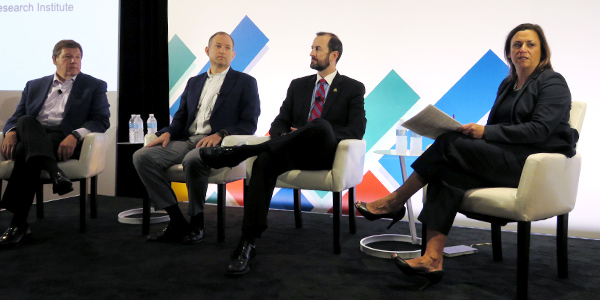By Rich Heidorn Jr.
PHILADELPHIA — “There’s probably no topic that inspires more emotions” than electromagnetic pulses (EMP), says Electric Power Research Institute CEO Michael Howard.
An Amazon search of the topic shows why, he said at the Edison Electric Institute’s 2019 conference here Tuesday. “I haven’t done this in a little while, but I know three years ago, the first 19 of the top 20 books [on EMPs] were science fiction. And [they talk] about the end of the world,” he said. “It’s not a good day, but it’s not the end of the world when you have an EMP blast. That emotion creates hysteria. It creates unrealistic understanding about what EMP is really about and what we need to do to mitigate the impact.”
In April, EPRI released a study that concluded a high-altitude nuclear explosion could cause a multistate electric outage but not the nationwide, months-long blackout some observers have warned of. (See EPRI Report Downplays Worst-Case EMP Scenario.) On Wednesday, a NERC task force met for the first time publicly to discuss the EPRI research and President Trump’s March 26 executive order directing the federal government to protect the nation’s critical infrastructure from EMPs. (See EMP Task Force Takes ‘First Bite of the Elephant.’)
Mark P. Harvey, the National Security Council’s senior director for resilience policy, told the EEI crowd the executive order was long overdue.
“It’s been a known threat for a long time, and we get a lot of questions that say, ‘Has the threat picture changed? Is somebody now more capable? Why are you doing this now?’” said Harvey. “Frankly, it was time to take action. We’ve known about this for so long, but we haven’t had decisive action.”
Harvey said those who consider the risk of a high-altitude EMP (HEMP) remote shouldn’t dismiss the threat.
“Twenty-five years ago, the Department of Energy proved you could take material that’s already posted online and build an EMP generating device for as little as $50 with a trip to Sally’s Beauty Supply and Home Depot and knock out power to a building about this size,” he said, referring to the Marriott Hotel where EEI met.
“Don’t think just missiles over the poles, high-altitude nuclear detonation when you’re thinking about EMP. … There are ways of doing this on smaller scale with flux compression devices [or] high-powered microwave devices that could be applied against particular critical infrastructure.”
Harvey said the potential impact of such an attack has been magnified because “our critical infrastructure not only is more interconnected than it ever has been, it is now to a point where its operating with as little excess capacity as possible. It is almost maxed out within our electric sector, our communications sector, our transportation networks. So, there is little margin for error and little margin for loss across all of those critical infrastructure sectors, especially when you consider how connected they are and that you can have cascading impacts.”
Moderator Caitlin Durkovich, a director at Toffler Associates and the Department of Homeland Security’s former assistant secretary for infrastructure protection, said she is amazed by the lack of awareness about the threats of EMPs and geomagnetic disturbances. “There are people who very much think this is a thing of science fiction. They would laugh and say, ‘Really? There’s something called space weather?’”
“We are very good at planning for what’s in the rear-view mirror,” she said. “We have to get better at planning for what’s on the horizon, and even the unimaginable.”
Robert Blue, CEO of Dominion Energy’s Power Delivery Group, noted his utility supplies power to the Pentagon and numerous defense contractors and military facilities, including the world’s largest naval base at Norfolk, Va. “And a large portion of the world’s Internet traffic goes through data centers that are ours … in Northern Virginia,” he added. “So, as we think about these issues, we feel like we have a particularly important role to play because of that customer base.”
Blue said Dominion began developing expertise and mitigation measures after a GMD event in March 1989 caused the failure of the Hydro Québec system and trips of capacitor banks that Dominion used to control voltage.
“We started off by changing the specs for substations — capacitors, transformers [to] make sure they have the ability to withstand GMD-type events. [We] improved our situational awareness … equipment changes, process changes,” he said. “That sort of view has transferred to much of what we do on other issues of physical and cybersecurity.”
David W. Roop, Dominion’s director of electric transmission operations and reliability, has become a national authority on GMDs and EMPs, testifying before Congress on the topic in February.
Harvey said utilities and other critical infrastructure providers are now in a role like that of police and firefighters after 9/11.
“We looked to cops and firefighters after 9/11 and said, ‘You’re on the front lines of the global war on terror,’ and they said, ‘Hold on, I’m not ready for that.’ We said, ‘That’s fine. We’re going to give you doctrine, we’re going to give you training, we’re going to give you tools. And they stepped up.
“Now you, your members, your colleagues, are on the front lines of the great power competition of the 21st century,” he told the audience. ” … The defining threat of this era is the asymmetric threat to critical infrastructure.”








